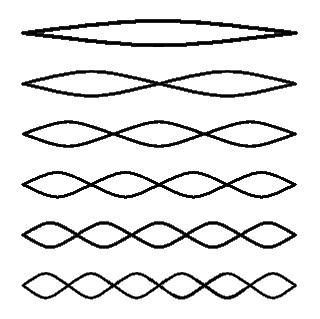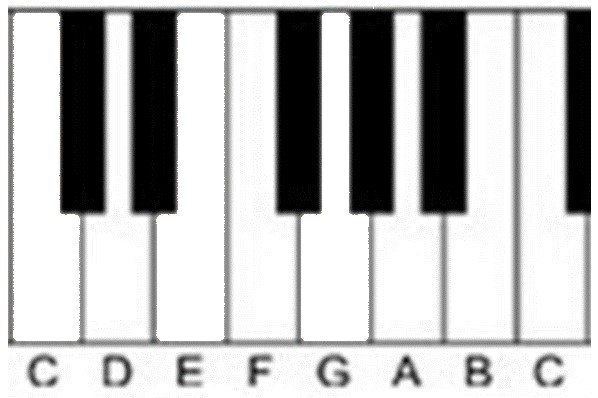
Listen to the big bronze bells in a church belfry or a village tower. How they ring and ring once they’ve been struck by the hammer. Now thump a kitchen pie plate; not quite the same sonic experience. What explains the huge difference in timbre? It is one of the mathematical beauties of nature. Let us enter the fascinating world of acoustics.
 One of the ironclad facts of life is that any vibrating body emits a tone (as long as the vibrations are within the range of the human ear, obviously). To demonstrate, find a guitar or violin string and pluck it. Look closely at that thrumming string: you can see the blur of the vibrations.
One of the ironclad facts of life is that any vibrating body emits a tone (as long as the vibrations are within the range of the human ear, obviously). To demonstrate, find a guitar or violin string and pluck it. Look closely at that thrumming string: you can see the blur of the vibrations.
Listen to the tone it emits. The particular pitch is determined by the number of times the string (or whatever vibrating body it happens to be, whether string, church bell, or the air column in a trombone) vibrates every second. Officially these are called cycles per second, or hertz (after one Heinrich Hertz, who died young but did a great deal to advance our understanding of magnetism). And yes, this is exactly the same concept that underlies the megahertz of the FM band and, for those of us of a certain age, the kilohertz of the AM band.
 Here’s where it starts to get interesting, because something very important is happening beyond our ability to perceive it: not only is the entire length of that string or air column or whatever vibrating, but every portion of it is vibrating as well: the two halves are vibrating, the three thirds are vibrating, as are the four fourths, the five fifths, etc., etc.
Here’s where it starts to get interesting, because something very important is happening beyond our ability to perceive it: not only is the entire length of that string or air column or whatever vibrating, but every portion of it is vibrating as well: the two halves are vibrating, the three thirds are vibrating, as are the four fourths, the five fifths, etc., etc.
The pitch you hear consciously, called the fundamental, is produced by the vibration of the entire body. The really interesting thing, though, and what drives this whole discussion, is that each of the subdivisions is emitting a tone, too. The sounds produced by the vibrations of the subdivisions are called harmonic partials. Since explaining the umbrella term partials is beyond our scope, we’ll focus on the harmonic part. Harmonics are the partials whose frequencies are higher than that of the fundamental, which is why acousticians often refer to them as overtones. The key thing is that we can’t consciously hear them, but they are what lend richness to the total sound experience.
And here is revealed one of the symmetrical beauties of Mother Nature: the speeds of vibration of those subdivisions, and thus the resulting pitches, are governed by a precise arithmetic pattern: the two halves are going twice as fast as the whole string, the three thirds are going three times as fast, etc., etc., up, up, faster and faster, generating ever higher tones.
Since the ascent of the overtones is an easy arithmetic progression, let’s calculate a set of them. We can start with a very low C, the one that sounds at 65 hertz, as the fundamental and build the series. Acousticians refer to the fundamental as the first harmonic. The pitch generated by the two halves of the vibrating body is thus the second harmonic and the first overtone:
Read this table from the bottom up:
| Vibrating portion |
Vibrations | Factor | × | 65 Hz | = | Result | Harmonic name |
Overtone name |
| four fourths | 4 | × | 65 Hz | = | 260 Hz | 4th harmonic | 3rd overtone | |
| three thirds | 3 | × | 65 Hz | = | 195 Hz | 3rd harmonic | 2nd overtone | |
| two halves | 2 | × | 65 Hz | = | 130 Hz | 2nd harmonic | 1st overtone | |
| whole body | 1 | × | 65 Hz | = | 65 Hz | 1st harmonic | fundamental |
All but the fundamental are only heard subconsciously, yes, but they are there, enriching the sound, their impact on our sonic experience getting progressively weaker as the subdivisions get smaller and smaller and the pitches produced get higher and higher. It’s all very neat and orderly: for the halves the factor is two, for the thirds the factor is three, etc.[i]
Each harmonic is a pitch at a specific "interval" above the first harmonic, an interval being the term musicians use to refer to the distance between two tones. To get the nomenclature right, we must recognize that musicians measure intervals using inclusive counting, which is the practice of calculating the distance between two quantities as including the starting point, something we just don’t do in everyday life. Moving from C up to G you count off four keys, but if you include the starting note it’s five, and musicians call the resulting interval a fifth.

While the names of these intervals may appear as mildly confusing technical terms to the layperson, musicians live and breathe them, even if they are intuitive musicians who can’t read music because you can literally harmonize any song in the Western musical system with the chords built on the unison, the fourth and the fifth (we'll explain this a little further down).
Let's take the above table and add the interval names.
Read this table from the bottom up:
| Vibrating portion |
Vibrations | Frequency | Harmonic name |
Overtone name |
Interval name |
Note |
| four fourths | 260 Hz | 4th harmonic | 3rd overtone | perfect fourth | C | |
| three thirds | 195 Hz | 3rd harmonic | 2nd overtone | perfect fifth | G | |
| two halves | 130 Hz | 2nd harmonic | 1st overtone | octave | C | |
| whole body | 65 Hz | 1st harmonic | fundamental | unison | C |
Before proceeding, an aside is absolutely necessary. Using a modern piano keyboard to illustrate these phenomena is not an ideal practice, for this reason: the notes we know today (C, F-sharp, B-flat, etc.) are the result of a massive and unbelievably complex compromise arrived at over a matter of centuries, called temperament, between musical practicality on the one hand and the laws of physics on the other.
Therefore, the frequencies I am assigning to the notes in my example are not, repeat NOT, precisely those you will hear if you try to follow along with a modern keyboard. For a readable account of the history of this fascinating topic, get a copy of How Equal Temperament Ruined Harmony (and Why You Should Care) by Ross W. Duffin (W.W. Norton, 2007).
Let’s finish the table out to the 8th harmonic/7th overtone. This way, we find that the fundamental tone reappears at one, two and three octaves above the fundamental:
| Vibrating portion |
Frequency | Harmonic name |
Overtone name |
Interval above previous pitch |
Note |
| eight eighths | 520 Hz | 8th harmonic | 7th overtone | three octaves above fundamental | C |
| seven sevenths | 455 Hz | 7th harmonic | 6th overtone | *no piano equivalent* | [iii] |
| six sixths | 390 Hz | 6th harmonic | 5th overtone | minor third | G |
| five fifths | 325 Hz | 5th harmonic | 4th overtone | major third | E |
| four fourths | 260 Hz | 4th harmonic | 3rd overtone | perfect fourth | C[ii] |
| three thirds | 195 Hz | 3rd harmonic | 2nd overtone | perfect fifth | G |
| two halves | 130 Hz | 2nd harmonic | 1st overtone | octave | C |
| whole body | 65 Hz | 1st harmonic | fundamental | unison | C |
(Hopefully you will not be surprised to learn that, with the sheer symmetrical beauty we have come to expect of Nature, this pattern of intervals above a fundamental is reproduced within a single octave. For an explanation, see my “The Birth of the Scales”.)
If you sing while driving down the road or in the privacy of your own shower or kitchen, you are engaging in what musicians call monophony, from the greek mono (μονο) meaning one and phonos (πηονοσ) meaning sound. Monophony is alive and well in Catholic monasteries where the monks sing Gregorian chant (technically known as plainchant); no matter how many monks are in the chapel, they are all singing the same notes, so monophony it is.
The moment you have more than one note sounding, you have harmony. Two people singing a capella is harmony; a 96-piece symphony orchestra is harmony. And when you have harmony, you start talking about chords. If you want to go Greek, you call it polyphony, poly, of course, meaning many. Let's refresh our memories about the keyboard:

Press the white keys in order from the C on the left to the C on the right (or the other way around if you like) and you have played the C Major scale (see “The Birth of the Scales” for the origins of "major" and "minor"). If you write a song using that scale, you naturally will want to harmonize it with chords. So let's build the three basic chords (if you want to be a cool person, you call these triads). Here is the C Major triad, and since it is built on the first "degree" of the scale, it is designated with a Roman numeral I.

Here is the IV chord, built on the fourth degree of the scale:

And here is the V chord, built on the fifth degree of the scale:

What do you notice about those blue keys? Every note in the scale is in at least one of those chords. Thus, these three chords are all you need to harmonize any tune written in the Western system.
| Root of chord |
Component notes |
| I | C E G |
| IV | F A C |
| V | G B D |
This system has been nominated functional harmony, and each of these chords has a function: I is the tonic, IV is the subdominant, and V is the dominant. The dominant dominates because it leads directly back to the tonic: get a keyboard, play these chords and you will hear how the V relentlessly "pulls" your ears back to the I. This sequence of chords, the dominant followed immediately by the tonic, is called an authentic cadence. If you really want to have some fun, play the IV chord followed immediately by the tonic, and, if you ever spent time in church, you will hear a very familiar sound: it's called a plagal cadence.
There are a lot of bar bands out there that have built whole careers on nothing but those three chords (some may be asking, Where's the dominant seventh??, but that is beyond
the scope of this introductory text.)
So that’s it, the foundational principle of the music available to modern humans. The overtone series is nobody’s cultural property, it’s a set of physical facts, like the rotation of the Earth or the speed of light.[iv] Anyone could have made this discovery, but it was The West that actually did it. In other words, there’s a reason why Western music dominates the world’s ears rather than, say, the pentatonic system of eastern Asia. I’ll allow a well-known scholar of early Western music to have the last word:
Chords in the Western (that is, European) music tradition, therefore, are not merely a culturally evolved arrangement of musical sounds into a system but a natural phenomenon based on the physical science of acoustics.
– Ross W. Duffin
How Equal Temperament Ruined
Harmony (and Why You Should Care)
W.W. Norton, 2007
On behalf of Western civilzation, I'd just like to say: you're welcome.
[i] Obviously, this sequence holds true in the same arithmetical pattern no matter what note you start with.
[ii] Note that this is two octaves above the fundamental.
[iii] Because of temperament, referred to above.
[iv] I’m reminded of a parody bumper sticker I saw in the dark days of the OPEC oil embargo; the original slogan ran: “55 miles per hour. It’s not just a good idea, it’s the law.” The satirical bumper sticker read, “186,000 miles per second. It’s not just a good idea, it’s the law.” It would not be out of bounds to print one of the same ilk beginning: “The overtone series…”